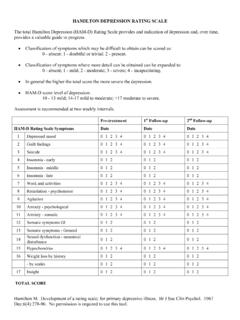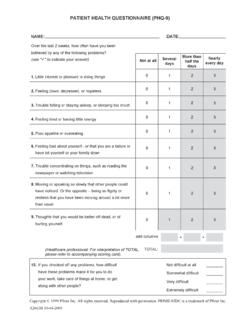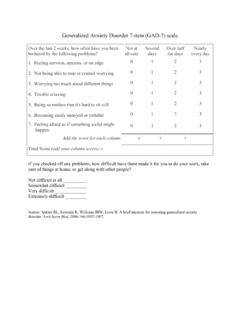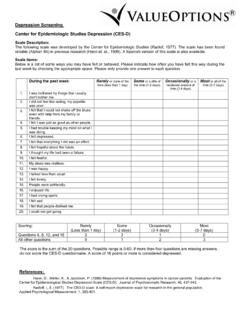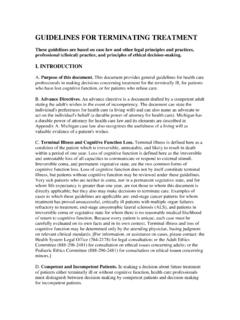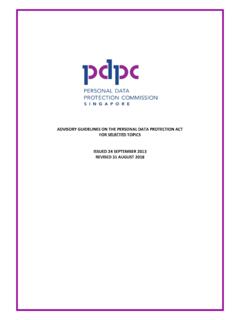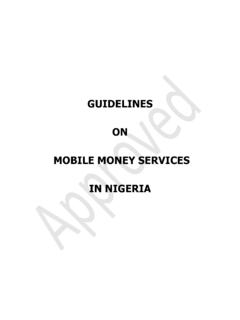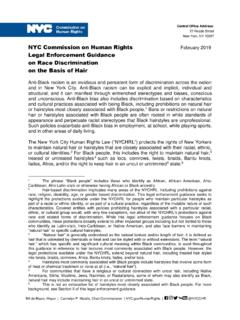Transcription of Implementing Medication-Assisted Treatment for Opioid Use ...
1 Implementing Medication-Assisted Treatment for Opioid Use Disorder in Rural Primary Care: Environmental Scan Volume 2 Tools and Resources The authors of this report are responsible for its content. Statements in the report should not be construed as endorsement by the Agency for Healthcare Research and Quality or the Department of Health and Human Services. Implementing Medication-Assisted Treatment for Opioid Use Disorder in Rural Primary Care: Environmental Scan Volume 2 Tools and Resources Prepared for: Agency for Healthcare Research and Quality 5600 Fishers Lane Rockville, MD.
2 Contract No. HHSP 233201500026I. Prepared by: Westat Rockville, MD. Garrett E. Moran Caroline M. Snyder Rebecca F. Noftsinger Joshua K. Noda AHRQ Publication No. 17(18)-0050-EF. October 2017. Disclaimer of Conflict of Interest None of the investigators has any affiliations or financial involvement that conflicts with the material presented in this report. Funding Statement This project was funded under Contract Number HHSP 233201500026I from AHRQ, Department of Health and Human Services. The opinions expressed in this document are those of the authors and do not reflect the official position of AHRQ or HHS.
3 Public Domain Notice This document is in the public domain and may be used and reprinted without special permission. Citation of the source is appreciated. Suggested citation: Moran GE, Snyder CM, Noftsinger RF, et al . Implementing medication- assisted Treatment for Opioid use disorder in rural primary care: environmental scan, volume 2. tools and resources. (Prepared by Westat under Contract Number HHSP 233201500026I, Task Order No. HHSP23337003T). Rockville, MD: Agency for Healthcare Research and Quality; October 2017. Publication No.
4 17(18)-0050-EF. Table of Contents Section Page Acknowledgments .. iv 1 Tools and Resources .. 1. Tables 1 Tools for the Prevention of Opioid Use Disorder .. T1-1. 2 Tools for Training/Education About Medication-Assisted T2-1. 3 Tools for Implementation of Medication-Assisted Treatment in Office-Based Settings .. T3-1. 4 Tools for Preventing or Responding to Opioid Overdose .. T4-1. Implementing MAT for OUD in Rural Primary Care: iii Environmental Scan (V2 Tools and Resources). Acknowledgments The authors would like to thank the following members of the AHRQ National Integration Academy Council (NIAC) for their reviews of and contributions to this document: James W.
5 Berry, , Associate Professor, Department of Behavioral Medicine and Psychiatry, West Virginia University School of Medicine; Center Director, Chestnut Ridge Center, West Virginia University Mark H. Duncan, , Acting Assistant Professor, Family Medicine and Psychiatry, Department of Psychiatry & Behavioral Sciences, University of Washington Noah Nesin, , FAAFP, Vice President of Medical Affairs, Penobscot Community Health Care The authors also thank Jeannine Sachar and Rebekah Zanditon of Westat for their searches of the literature.
6 Implementing MAT for OUD in Rural Primary Care: iv Environmental Scan (V2 Tools and Resources). 1. Tools and Resources A variety of tools and resources are available for providers and patients who offer or use Medication-Assisted Treatment (MAT) services. As part of this environmental scan, a list of tools has been assembled for use in the implementation of MAT. Although the tools were not all created specifically for rural primary care practices, they are potentially useful in those and other settings. The tools and resources found by this environmental scan are listed and described in the tables that follow.
7 They come from a variety of public and private sources. For example, many government entities, such as the Office of the Surgeon General, Centers for Disease Control and Prevention (CDC), Substance Abuse and Mental Health Services Administration (SAMHSA), National Institute on Drug Abuse (NIDA), Department of Veterans Affairs, Indian Health Service (IHS), and Office of Disease Prevention and Health Promotion, have created a number of useful tools related to Opioid use disorder (OUD) and MAT. Tools included in the tables were identified through methodical searches of the published and grey literature and through individual searches for specific kinds of tools.
8 The methodology section in Volume 1 addresses the search methods in greater detail. Among the resources are the NIDA-funded BupPractice, which provides many tools for both providers and patients. BupPractice offers buprenorphine waiver training for physicians, nurse practitioners, and physician assistants. In addition, the Providers' Clinical Support System for Medication Assisted Treatment (PCSS-MAT) is a collaborative effort led by the American Academy of Addiction Psychiatry (AAAP) in partnership with the American Osteopathic Academy of Addiction Medicine (AOAAM) and a broad network of other addiction-related organizations.
9 This effort provides training and a mentoring project that helps providers implement MAT for OUD in a variety of settings, including primary care. Professional societies also provide a wealth of resources for their members and the public that can be used in Implementing MAT for OUD. These include but are not limited to the American Society of Addiction Medicine (ASAM), AAAP, AOAAM, American Psychiatric Association, American Medical Association, and California Society of Addiction Medicine. Other materials have been developed by institutions of higher education and medical professionals for use in their practices.
10 Many of these organizations and others are also partners in the PCSS-MAT initiative. Implementing MAT for OUD in Rural Primary Care: 1. Environmental Scan (V2 Tools and Resources). In the tables, the tools have been categorized by topic, although there are many different types and formats. For example, there are materials that can be used for provider, patient, and community education, such as guidelines, toolkits, training materials, and fact sheets. Further, some of these tools, such as screening and assessment instruments, consent forms, patient agreements and contracts, implementation materials and checklists, protocols, and web- or mobile-based applications, can be used in practice.
